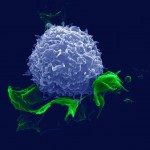Lien vers Pubmed [PMID] – 23488628
Stem Cells Dev. 2013 Aug;22(15):2121-31
The mechanisms underlying the specification of oligodendrocyte fate from multipotent neural progenitor cells (NPCs) in developing human brain are unknown. In this study, we sought to identify antigens sufficient to distinguish NPCs free from oligodendrocyte progenitor cells (OPCs). We investigated the potential overlap of NPC and OPC antigens using multicolor fluorescence-activated cell sorting (FACS) for CD133/PROM1, A2B5, and CD140a/PDGFαR antigens. Surprisingly, we found that CD133, but not A2B5, was capable of enriching for OLIG2 expression, Sox10 enhancer activity, and oligodendrocyte potential. As a subpopulation of CD133-positive cells expressed CD140a, we asked whether CD133 enriched bone fide NPCs regardless of CD140a expression. We found that CD133(+)CD140a(-) cells were highly enriched for neurosphere initiating cells and were multipotent. Importantly, when analyzed immediately following isolation, CD133(+)CD140a(-) NPCs lacked the capacity to generate oligodendrocytes. In contrast, CD133(+)CD140a(+) cells were OLIG2-expressing OPCs capable of oligodendrocyte differentiation, but formed neurospheres with lower efficiency and were largely restricted to glial fate. Gene expression analysis further confirmed the stem cell nature of CD133(+)CD140a(-) cells. As human CD133(+) cells comprised both NPCs and OPCs, CD133 expression alone cannot be considered a specific marker of the stem cell phenotype, but rather comprises a heterogeneous mix of glial restricted as well as multipotent neural precursors. In contrast, CD133/CD140a-based FACS permits the separation of defined progenitor populations and the study of neural stem and oligodendrocyte fate specification in the human brain.

